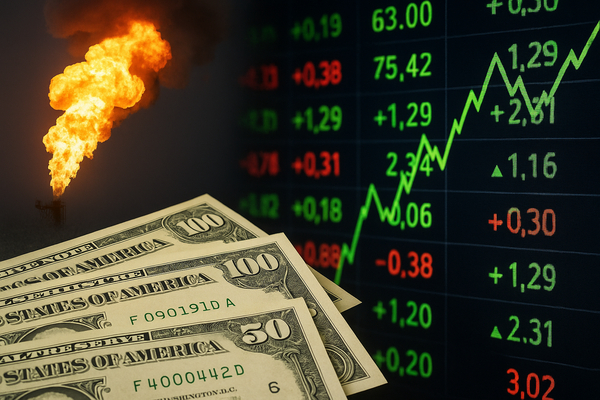
US-China trade flare-up and juiced bonds are reshaping market moves and driving short-term volatility as investors brace for bank earnings and key policy speeches. The rare earths spat between Washington and Beijing triggered sharp risk-off flows and a surge in gold, while compressed yields in global fixed income are pushing capital into higher-yielding corners of the market. This matters now because earnings start tomorrow and global financial leaders meet in Washington, creating a tight window for fresh geopolitical or policy shocks to amplify moves. In the near term expect choppy trading. Over the longer term, low public bond yields and stretched equity multiples raise questions about where returns will come from.
US-China rare earths clash rattles risk assets but then cooled
Markets reacted violently to a weekend sequence of events that began with Chinese rare earth export curbs and strong US rhetoric. President Donald Trump criticized Beijing and threatened 100% tariffs, pushing the S&P 500 to its worst weekly loss since May and sending bullion to fresh highs above $4,070 an ounce. The episode then softened after conciliatory comments from the US side and Beijing postponed a call, leaving investors to parse mixed messages.
That back and forth matters now because it raises uncertainty about whether existing bilateral trade arrangements will be extended on November 10 or whether a planned summit will proceed. In the short term this kind of tit-for-tat can amplify moves in sectors reliant on rare earths, such as electric vehicles, defence and green energy supply chains. In the longer term, the spat underlines the strategic leverage that concentrated supply positions create for global manufacturing and trade flows.
The data flow adds nuance. China reported export growth faster than forecast for September overall, even as shipments to the US fell 27% year on year. Exports to the European Union, Southeast Asia and Africa rose 14%, 16% and 56% respectively. Those shifts underscore how global trade patterns can reorient quickly when geopolitical risk spikes.
Compressed yields push investors toward higher-risk and niche markets
Friday’s risk-off move pushed two and 10 year US Treasury yields to their lowest levels in almost a month and forced the dollar to retreat. That safe-haven rush also supported gold, which registered record levels. The moves illustrate how low nominal yields can change investor behavior.
Industry and market commentators say a very large slice of public bonds now yields less than 5%. Apollo’s chief economist Torsten Slok noted that almost 90% of public fixed income trades below that threshold. With core inflation for major economies around 3%, the implied real return on much public debt can be modest. That dynamic helps explain why private credit, tech and AI investments, and even gold are attracting more capital than they would in a higher yield environment.
Scale also matters. Global fixed income outstanding stood at about $145.1 trillion through last year, larger than global equity market capitalization near $126.7 trillion. That creates a huge universe of relatively meager long-term returns in public markets, which in turn pressures allocators to seek alternative sources of yield. However, many of those alternative markets carry different liquidity and transparency profiles than public bonds, which has implications for systemic risk and portfolio construction.
Bank earnings kick off and markets want proof on earnings growth
Earnings season begins in earnest with major US banks reporting. JPMorgan Chase (NYSE:JPM) and Wells Fargo (NYSE:WFC) open the session, with JPMorgan slated to report and host a call early in the morning. Goldman Sachs (NYSE:GS) and Citigroup (NYSE:C) follow. The market will watch whether reported results support the roughly 8.8% year on year S&P 500 earnings per share growth that underpins current multiples.
Bank results will be read for lending trends, trading revenue, loan loss provisions and any signs of deposit flight or funding stress. Those micro signals matter in the short run because they can trigger sector rotation or extend a market correction. In addition, the macro backdrop is in focus. Treasury markets are closed for Columbus Day and the US government remains in partial shutdown, limiting some market liquidity right as big corporate data arrive.
Investors also face an event calendar that includes key appearances at the IMF and World Bank annual meetings in Washington. Federal Reserve chair Jerome Powell is due to speak, and regulators have issued caution about overextended valuations. Financial Stability Board chair Andrew Bailey warned that elevated valuations could be at odds with an uncertain economic and geopolitical outlook, increasing vulnerability to a disorderly adjustment.
Geopolitics, politics and commodity hedges keep pressure on markets
Geopolitical developments added to risk calculations. The start of hostage releases in Israel and a high profile presidential visit drew attention to regional stability. In Europe, French Prime Minister Sebastien Lecornu was reappointed and will name a new cabinet while Roland Lescure remains at finance. That continuity reduces near-term political risk in Paris but does not remove budgetary challenges ahead.
Markets reacted to these developments by favoring safe assets briefly and then rotating as headlines evolved. Currency moves were notable with the dollar retreating at first then regaining ground against the yen and franc. Gold’s advance to record levels reflects investor demand for hedges against policy and geopolitical uncertainty. For sectors tied to strategic metals and magnets, the rare earths episode highlights supply chain vulnerability and the potential for sudden price and availability shocks.
Overall, the combination of geopolitical noise, compressed public yields and a major earnings test creates a session where headlines will matter. Short-term volatility may be high as traders price through earnings surprises and policy commentary. Over the medium term, persistent low yields and reoriented trade flows will continue to influence allocations and capital deployment decisions.
Markets open with these crosscurrents in place and a full slate of corporate and policy events ahead. Traders will watch bank reports, Powell’s remarks, IMF-World Bank commentary and any further developments on rare earths closely. The interaction between earnings evidence and macro policy signals will shape risk appetite for the rest of the week.












